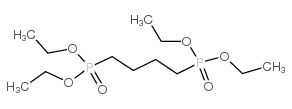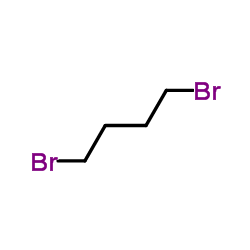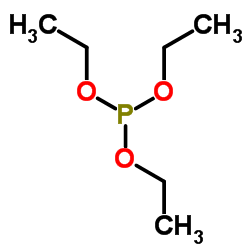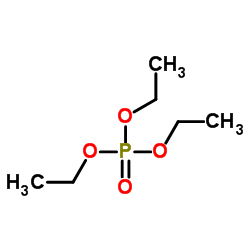7203-67-0
| 英文名 | tetraethyl(1,4-butylene)bisphosphonate |
|---|---|
| 英文别名 |
Butandiyl-bis-phosphonsaeure-tetraaethylester
butanediyl-bis-phosphonic acid tetraethyl ester TETRAETHYL BUTYLENEDIPHOSPHONATE 1,4-Bis-diaethoxyphosphoryl-butan Tetraethylbutylene-1,4-diphosphonate Butandiyldiphosphonsaeure-tetraaethylester MFCD00015135 |
| 描述 | Tetraethyl butane-1,4-diylbis(phosphonate) 是一种 PROTAC linker,属于 alkyl chain 类。可用于合成 PROTAC 分子。 |
|---|---|
| 相关类别 | |
| 靶点 |
Alkyl-Chain |
| 体外研究 | PROTACs包含两种不同的配体,它们通过连接体连接;一种是E3泛素连接酶的配体,另一种是靶蛋白的配体。PROTACs利用细胞内泛素-蛋白酶体系统选择性降解靶蛋白[1]。 |
| 参考文献 |
| 密度 | 1.099g/cm3 |
|---|---|
| 沸点 | 415.8ºC at 760 mmHg |
| 分子式 | C12H28O6P2 |
| 分子量 | 330.29500 |
| 闪点 | 218.7ºC |
| 精确质量 | 330.13600 |
| PSA | 90.68000 |
| LogP | 4.29880 |
| 折射率 | 1.4465-1.4485 |
| 储存条件 | 密封储存,储存于阴凉、干燥的库房。 |
| 稳定性 | 避免与不相容材料接触。 与强氧化剂反应。 |
| 计算化学 | 1.疏水参数计算参考值(XlogP):0.9 2.氢键供体数量:0 3.氢键受体数量:6 4.可旋转化学键数量:13 5.互变异构体数量:无 6.拓扑分子极性表面积71.1 7.重原子数量:20 8.表面电荷:0 9.复杂度:282 10.同位素原子数量:0 11.确定原子立构中心数量:0 12.不确定原子立构中心数量:0 13.确定化学键立构中心数量:0 14.不确定化学键立构中心数量:0 15.共价键单元数量:1 |
| 更多 | 1. 性状:无色透明液体 2. 密度(g/mL,20℃):未确定 3. 相对蒸汽密度(g/mL,空气=1):未确定 4. 熔点(ºC):未确定 5. 沸点(ºC,常压):未确定 6. 沸点(ºC,3mmHg):未确定 7. 折射率(n20/D):1.4465-1.4485 8. 闪点(ºC):未确定 9. 比旋光度(º):未确定 10. 自燃点或引燃温度(ºC):未确定 11. 蒸气压(mmHg,217ºC):未确定 12. 饱和蒸气压(kPa,25ºC):未确定 13. 燃烧热(KJ/mol):未确定 14. 临界温度(ºC):未确定 15. 临界压力(KPa):未确定 16. 油水(辛醇/水)分配系数的对数值:未确定 17. 爆炸上限(%,V/V):未确定 18. 爆炸下限(%,V/V):未确定 19. 溶解性:未确定 |
Synonym:None Known Section 2 - COMPOSITION, INFORMATION ON INGREDIENTS
Risk Phrases: None Listed. Section 3 - HAZARDS IDENTIFICATION EMERGENCY OVERVIEW
The toxicological properties of this material have not been fully investigated. Potential Health Effects Eye: May cause eye irritation. Skin: May cause skin irritation. May be harmful if absorbed through the skin. Ingestion: May cause irritation of the digestive tract. The toxicological properties of this substance have not been fully investigated. May be harmful if swallowed. Inhalation: May cause respiratory tract irritation. The toxicological properties of this substance have not been fully investigated. May be harmful if inhaled. Chronic: No information found. Section 4 - FIRST AID MEASURES Eyes: In case of contact, immediately flush eyes with plenty of water for at least 15 minutes. Get medical aid. Skin: In case of contact, flush skin with plenty of water. Remove contaminated clothing and shoes. Get medical aid if irritation develops and persists. Wash clothing before reuse. Ingestion: If swallowed, do not induce vomiting unless directed to do so by medical personnel. Never give anything by mouth to an unconscious person. Get medical aid. Inhalation: If inhaled, remove to fresh air. If not breathing, give artificial respiration. If breathing is difficult, give oxygen. Get medical aid. Notes to Physician: Treat symptomatically and supportively. Section 5 - FIRE FIGHTING MEASURES General Information: As in any fire, wear a self-contained breathing apparatus in pressure-demand, MSHA/NIOSH (approved or equivalent), and full protective gear. During a fire, irritating and highly toxic gases may be generated by thermal decomposition or combustion. Vapors may be heavier than air. They can spread along the ground and collect in low or confined areas. Runoff from fire control or dilution water may cause pollution. Extinguishing Media: Use water spray, dry chemical, carbon dioxide, or chemical foam. Section 6 - ACCIDENTAL RELEASE MEASURES General Information: Use proper personal protective equipment as indicated in Section 8. Spills/Leaks: Absorb spill with inert material (e.g. vermiculite, sand or earth), then place in suitable container. Avoid runoff into storm sewers and ditches which lead to waterways. Clean up spills immediately, observing precautions in the Protective Equipment section. Provide ventilation. Section 7 - HANDLING and STORAGE Handling: Wash thoroughly after handling. Use with adequate ventilation. Avoid breathing dust, vapor, mist, or gas. Avoid contact with eyes, skin, and clothing. Keep container tightly closed. Avoid ingestion and inhalation. Storage: Store in a cool, dry place. Store in a tightly closed container. Section 8 - EXPOSURE CONTROLS, PERSONAL PROTECTION Engineering Controls: Facilities storing or utilizing this material should be equipped with an eyewash facility and a safety shower. Use adequate ventilation to keep airborne concentrations low. Exposure Limits CAS# 7203-67-0: Personal Protective Equipment Eyes: Wear chemical splash goggles. Skin: Wear appropriate protective gloves to prevent skin exposure. Clothing: Wear appropriate protective clothing to prevent skin exposure. Respirators: Follow the OSHA respirator regulations found in 29 CFR 1910.134 or European Standard EN 149. Use a NIOSH/MSHA or European Standard EN 149 approved respirator if exposure limits are exceeded or if irritation or other symptoms are experienced. Section 9 - PHYSICAL AND CHEMICAL PROPERTIES Physical State: Clear liquid Color: colorless Odor: Not available. pH: Not available. Vapor Pressure: Not available. Viscosity: Not available. Boiling Point: Not available. Freezing/Melting Point: Not available. Autoignition Temperature: Not available. Flash Point: Not available. Explosion Limits, lower: Not available. Explosion Limits, upper: Not available. Decomposition Temperature: Solubility in water: Specific Gravity/Density: Molecular Formula: C12H28O6P2 Molecular Weight: 330.14 Section 10 - STABILITY AND REACTIVITY Chemical Stability: Not currently available. Conditions to Avoid: Incompatible materials, excess heat. Incompatibilities with Other Materials: Strong oxidizing agents. Hazardous Decomposition Products: Carbon monoxide, oxides of phosphorus, carbon dioxide. Hazardous Polymerization: Has not been reported Section 11 - TOXICOLOGICAL INFORMATION RTECS#: CAS# 7203-67-0 unlisted. LD50/LC50: Not available. Carcinogenicity: Tetraethylbutylene-1,4-diphosphonate - Not listed by ACGIH, IARC, or NTP. Section 12 - ECOLOGICAL INFORMATION Section 13 - DISPOSAL CONSIDERATIONS Dispose of in a manner consistent with federal, state, and local regulations. Section 14 - TRANSPORT INFORMATION IATA Not regulated as a hazardous material. IMO Not regulated as a hazardous material. RID/ADR Not regulated as a hazardous material. Section 15 - REGULATORY INFORMATION European/International Regulations European Labeling in Accordance with EC Directives Hazard Symbols: Not available. Risk Phrases: Safety Phrases: S 24/25 Avoid contact with skin and eyes. WGK (Water Danger/Protection) CAS# 7203-67-0: No information available. Canada None of the chemicals in this product are listed on the DSL/NDSL list. CAS# 7203-67-0 is not listed on Canada's Ingredient Disclosure List. US FEDERAL TSCA CAS# 7203-67-0 is not listed on the TSCA inventory. It is for research and development use only. SECTION 16 - ADDITIONAL INFORMATION N/A |
| 安全声明 (欧洲) | S24/25 |
|---|
|
~93% 
7203-67-0 |
| 文献:Griffith, Julie A.; McCauley, David J.; Barrans Jr., Richard E.; Herlinger, Albert W. Synthetic Communications, 1998 , vol. 28, # 23 p. 4317 - 4323 |
|
~% 
7203-67-0 |
| 文献:Baizer,M.M.; Anderson,J.D. Journal of Organic Chemistry, 1965 , vol. 30, p. 3138 - 3141 |
|
~% 
7203-67-0 |
| 文献:Bogonoszewa Uchenye Zapiski, Kazanskii Gosudarstvennyi Universitet, 1956 , vol. 116, # 2 p. 71,108, 109 Chem.Abstr., 1957 , p. 6581 Show Details Schwarzenbach; Zurc Monatshefte fuer Chemie, 1950 , vol. 81, p. 202,206 |
|
~% 
7203-67-0 |
| 文献:Tian, Tao; Yang, Weiting; Wang, Hao; Dang, Song; Sun, Zhong-Ming Inorganic Chemistry, 2013 , vol. 52, # 15 p. 8288 - 8290 |






